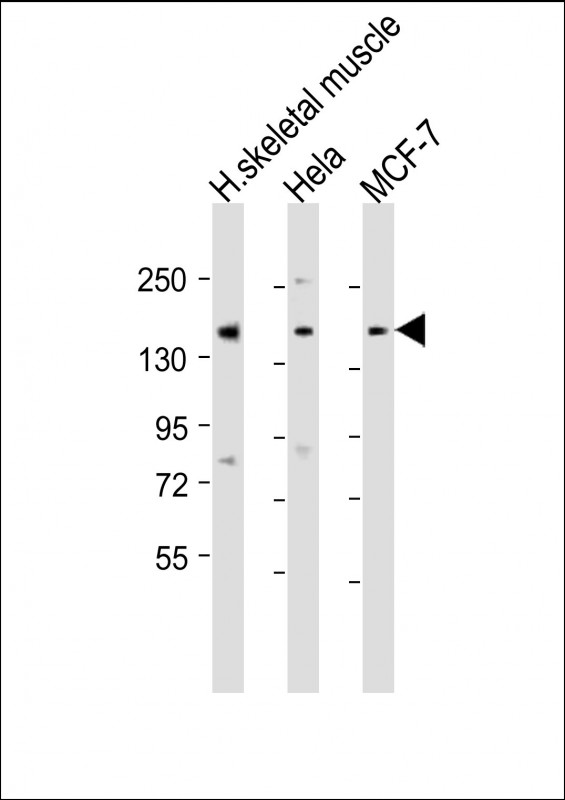
| WB | 1/1000-1/2000 | Human,Mouse,Rat |
| IF | 咨询技术 | Human,Mouse,Rat |
| IHC | 咨询技术 | Human,Mouse,Rat |
| ICC | 技术咨询 | Human,Mouse,Rat |
| FCM | 咨询技术 | Human,Mouse,Rat |
| Elisa | 咨询技术 | Human,Mouse,Rat |
| Aliases | Trinucleotide repeat-containing gene 6A protein, CAG repeat protein 26, EMSY interactor protein, GW182 autoantigen, Protein GW1, Glycine-tryptophan protein of 182 kDa, TNRC6A, CAGH26, KIAA1460, TNRC6 |
| Entrez GeneID | 27327 |
| WB Predicted band size | 210.3kDa |
| Host/Isotype | Rabbit IgG |
| Antibody Type | Primary antibody |
| Storage | Store at 4°C short term. Aliquot and store at -20°C long term. Avoid freeze/thaw cycles. |
| Species Reactivity | Human, Mouse |
| Immunogen | This TNRC6A antibody is generated from a rabbit immunized with a KLH conjugated synthetic peptide between 855-885 amino acids from the Central region of human TNRC6A. |
+ +
以下是3篇与TNRC6A抗体相关的文献摘要信息,涵盖其功能研究和应用方向:
---
1. **文献名称**:*"GW182 proteins directly recruit cytoplasmic deadenylase complexes to miRNA targets"*
**作者**:Chen Y. et al.
**摘要**:该研究通过免疫共沉淀(Co-IP)实验,利用TNRC6A特异性抗体,揭示了TNRC6A作为GW182家族成员在miRNA介导的基因沉默中的作用机制。研究发现TNRC6A通过与CCR4-NOT脱腺苷酶复合体结合,直接促进靶标mRNA的降解。
---
2. **文献名称**:*"Structural basis for miRNA targeting by the TNRC6A-GW182 silencing complex"*
**作者**:Elkayam E. et al.
**摘要**:本研究通过结构生物学方法结合TNRC6A抗体进行功能验证,解析了TNRC6A与Argonaute蛋白(AGO)的相互作用界面,阐明其如何通过GW重复结构域招募沉默复合体至miRNA靶标位点,为RNA干扰机制提供结构基础。
---
3. **文献名称**:*"A role for TNRC6A in hepatocellular carcinoma progression via miRNA dysregulation"*
**作者**:Wang L. et al.
**摘要**:该文献使用TNRC6A抗体进行免疫组化分析,发现TNRC6A在肝癌组织中表达显著上调,并通过调控miRNA网络促进肿瘤细胞增殖和转移,提示其作为潜在治疗靶点的可能性。
---
**备注**:若需获取具体抗体品牌或实验细节,建议补充筛选条件(如应用场景、物种特异性等)。以上文献可在PubMed或Web of Science通过标题/作者检索原文。
The TNRC6A (Trinucleotide Repeat-Containing Protein 6A) antibody is a crucial tool for studying the molecular mechanisms of RNA-mediated gene silencing. TNRC6A, also known as GW182. is a key component of the RNA-induced silencing complex (RISC), where it interacts with Argonaute (Ago) proteins to mediate microRNA (miRNA)- or small interfering RNA (siRNA)-directed post-transcriptional gene regulation. It facilitates translational repression, deadenylation, and degradation of target mRNAs by recruiting effector complexes, including deadenylases and decapping enzymes.
Antibodies targeting TNRC6A are widely used in research to investigate its expression, localization, and interactions in cellular pathways. They enable techniques such as Western blotting, immunoprecipitation (IP), and immunofluorescence (IF) to explore TNRC6A's role in development, cancer, and neurological disorders, where dysregulated miRNA activity is implicated. Specificity and validation are critical, as TNRC6A shares homology with family members TNRC6B and TNRC6C. High-quality antibodies are often validated using knockout cell lines or siRNA knockdown to confirm target recognition.
Researchers rely on TNRC6A antibodies to dissect its contributions to gene silencing dynamics, providing insights into therapeutic strategies targeting miRNA pathways. Proper antibody selection depends on experimental needs, including species reactivity (human, mouse, rat) and application compatibility (e.g., IHC, ChIP).
×